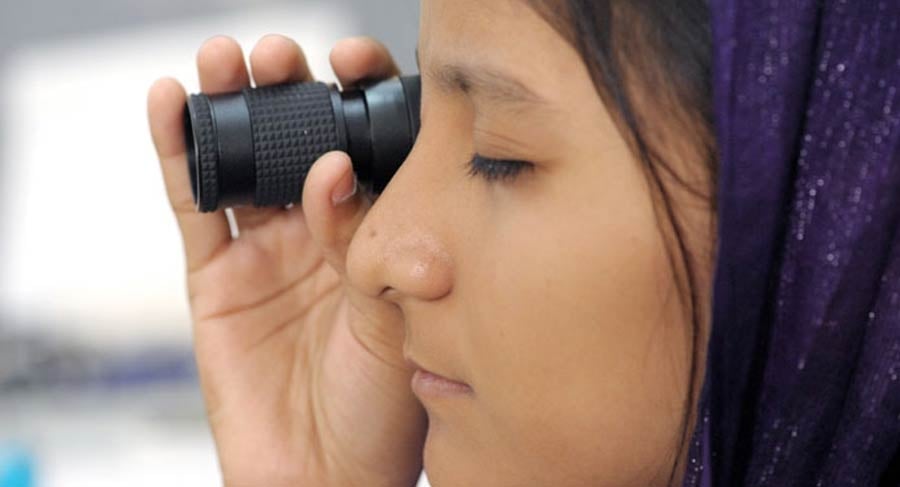Karachi, Pakistan, 22 May 2015: Imagine travelling a great distance to have your eyes checked only to learn that your vision impairment cannot be reversed or improved? This would come as a shock for anyone, especially if it was followed with the phrase, “I’m sorry, at this stage we can’t do anymore to help you. We don’t have access to low vision services here.”
Like any other sense, vision tends to deteriorate or diminish naturally with age. In most cases, reduction in visual capability can be corrected with glasses, medicine or surgery. However, if the visual changes have occurred because of an incurable eye disease, condition or injury, vision loss can be permanent and the person will result with ‘low vision’.
Low vision can impact a person’s life in a major ways causing them to struggle with completing everyday tasks, causing dependency and a reduced quality of life. Access to low vision services is a crucial conduit to improving their daily life by restoring capabilities.
Over the last two years the number of eye clinics supported by the Institute which provide low vision services has increased to more than 100. A breakdown across the countries indicates current clinic figures are as follows: 50 in Nigeria, 20 in Pakistan, 15 in East Africa, 15 in China and one in Vietnam.
Hasan Minto, Director of Sustainable Service Development, Brien Holden Vision Institute, explains the strategy behind this much needed increase in low vision services is both integrated and comprehensive. It includes providing training for existing clinic or health care staff in low vision skills enabling them to firstly diagnose and secondly train the patient to effectively use the low vision devices they need.
“It is very important that people with low vision realise that their vision loss does not necessarily mean giving up all their life activities as this can lead to negative feelings of isolation, depression and frustration, but it does mean applying new ways of doing them. Many people can learn to function quite efficiently with only small amounts of visual information and devices to assist them. Objects and print can still be recognised when they are blurred or when only parts of them can be seen,” said Hasan.
Whether the disability is moderate, severe or profound, if people with low vision are provided with a broad understanding of their condition, given proper training in visual skills and assistance with visual aids, they can be taught effectively how to make the most of their remaining sight and keep their independence.
Low vision can be caused by eye diseases, such as macular degeneration, glaucoma, diabetic retinopathy and retinitis pigmentosa. It can also be caused by eye injuries, cancer of the eye, albinism or a brain injury. These conditions can occur at any age but are more common in older people. However, normal aging of the eye does not necessarily lead to low vision.
Alishba’s story
In Pakistan, Brien Holden Vision Institute works in partnership with Layton Rahmatullah Benevolent Trust (LRBT) to establish low vision services. The Institute has so far established eight new low vision clinics at LRBT’s hospitals across Pakistan and upgraded the infrastructures of a further two clinics. This intervention has contributed towards providing low vision services to vulnerable communities where there was previously an unmet need.
One of the beneficiaries of these low vision services is Alishba, a fourteen year old high school student from Karachi. For this active and intelligent student it was a matter of concern when, at ten years old, her class performance started declining. She couldn’t understand why she suddenly had a problem reading words on the chalk board and started having to depend on other students to help her see objects at a distance.
“Fear,” she said is the only word that came to mind when asked how she felt about her situation. As the months passed and her vision worsened, her fear started to grow into distress and her normal behaviour began to change.
Gravely concerned, her parents took her to LRBT’s hospital in Karachi for a complete eye examination where they were referred to the low vision clinic. It was here Alishba was diagnosed with cone dystrophy. As part of her treatment she was led through various appropriate training exercises in addition to being given spectacles and a telescope to aid her seeing.
Since then everything has improved for Alishba. In her own words, she smiled and said, “my life is easy now.” Before she had nothing but a distant hope to see again like she used to, but now she is not only seeing again, the confidence she once had, learning at school and existing in her daily life, is back.
On a global scale there are many people just like Alishba who have benefitted from the low vision services being provided by the Institute and partners. Supporting people with low vision and enabling them to lead a better life with correct assessment, training and devices is a critical intervention to enable independence.


